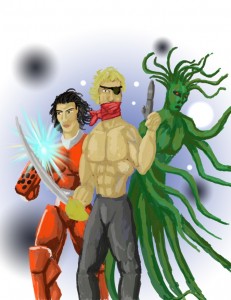Still thinking about a solo RPG engine, I keep resorting to randomizers which tend to produce a mish mash of results. Sometimes a randomizer is brilliant, most times it just isn’t. The other element that I’ve been working off of is standard story tropes and trying to create a choose your own adventure on the fly but the engine still is to vague to guide a player.
What I have so far is to set the classic three act structure and then split those acts into two scenes each. The player could add scenes for a longer game but the idea is to start at two. Each scene gets a classic motivation that will be dominant. Here’s the structure I posted over on 1KM1KT a little while back.
Act 1
Scene 1 Character generation. Get familiar with the character and set up a nice cushy life for them. Maybe they just got married. Maybe they just started a business and it's booming. Give them something nice.
Scene 2 A call to action. Roll against the motivations and use it to create the quest. If it's a positive motivation, then the character may have to leave the good life to take up the quest. The character taking up the quest could be reluctant if the call is from a positive source. If it was negative then something the character loved is destroyed. This should be played out in your rules but keep in mind that the odds are stacked in the favor of the motivation rolled. Maybe the character's business is saved but they realize that this kind of thing will keep happening unless they do something about it.
Act 2
Scene 1 Set up for the fall. The events of this scene set the player up for failure. If the scene is positive, the character thought they were doing the right thing but finds out it was all a trap, or he hurts the wrong people and has now made enemies. For motives like "Someone that helps" perhaps a mentor informs the character that they will have to accomplish some extraordinary task to succeed.
Scene 2 Put them in the worst position you can imagine. This is where the character is brought as low as they can go. (I'd have to work up ways of using the positive motivations to do this.)
Act 3
Scene 1 Get them out of it. The character must escape from jail, beat back the robot hordes, whatever.
Scene 2 Resolution. The final showdown. Will this be a comedy or a tragedy?
In each scene other than character generation roll on the following table.
Roll 1d20
1 Someone to pursue a goal (the Protagonist)
2-3 Someone to avoid the goal (the Antagonist)
4 Someone that helps (like a mentor)
5-7 Someone that hinders
8 Someone encouraging to consider a plan
9 Someone encouraging to reconsider a plan
10 Someone encouraging logic or reason
11 Someone encouraging feeling or emotional fulfillment
12 Someone encouraging excersizing control
13 Someone encouraging being uncontrolled
14 Someone to appeal to conscience
15-16 Someone to appeal to temptation
17 Someone who supports (speaks for) efforts
18 Someone who opposes (speaks against) efforts
19 Someone to express faith
20 Someone to disbelieve
The next piece of the puzzle is to give the player goal posts to reach in the story. This might be randomly generated, something to the effect of, “The main character is pressed by enemies until a resource is used up.” Which would be followed up by specific guidance that this could mean health, meaning the character is severely wounded, ammunition, fuel, food, water or whatever resource the player might target. Pick a target and then play the scene out until they’ve reached that low point. Others might be “Trapped on all sides” or “Outmatched in skill” with the idea of having a healthy list to work off of.
Lastly, I wanted to think about classic solo games and what they use to entertain the player. There are only a few general strategies that I’m aware of.
First is the puzzle, games like solitaire create a puzzle to solve by restricting the type of moves available and then scrambling the resources the player needs. I haven’t worked out how to do this in an RPG yet.
Next is the mob, a lot of games have a number of pieces that automatically move toward the player’s pieces and the player must avoid or defend against the mob. This is more native to an RPG but one of the things that most games of this type focus on is strategic movement. For RPGs that use miniatures and grids to play, this is slightly easier to emulate but there are a large number of games that do not handle tactical movement. I have to resist the temptation to create additional rules to fill in the blanks. There needs to be a way to use existing rules, even when they’re not well developed for this kind of challenge.
The third is the stronghold, where the players must out maneuver defenses to gain access to a specified point. This at first looks easy but is one of the hardest to accomplish since the defenses have to be well arranged and the underlaying pattern should be difficult for the player to unravel. Only, the player is the one setting up the defenses so already has intimate knowledge of them. Still, using something like the Tech Challenges in The Artifact could simulate this.
The fourth is spending resources, here the player has what he needs to accomplish the task and can apply the resources in many different ways but only a small subset of approaches will actually work.
I think these structures could flesh out how the player builds a scene but there needs to be specific instructions on how they’re implemented. That’s what I’ll be working on next, adapting these structures to RPGs so that using them is a connect the dots for the player.


